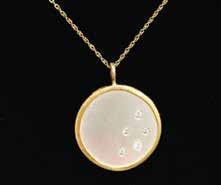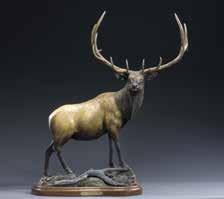
13 minute read
ART SCENE
Best of JH
ART SCENE
Advertisement
Icon of the West
Noppadol Paothong’s photography exhibit at the National Museum of Wildlife Art highlights the importance of greater sage-grouse to Western culture and conservation.
BY MAGGIE THEODORA // PHOTOGRAPHY BY NOPPADOL PAOTHONG
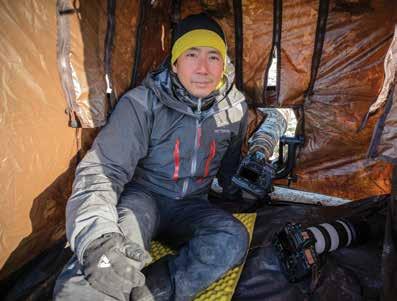

—DR. TAMMI HANAWALT, CURATOR OF ART AT NMWA
WILDLIFE PHOTOGRAPHER NOPPADOL Paothong spent eleven years working on his first book, Save the Last Dance. It features images of seven species of North American grassland grouse. His second book, Sage Grouse: Icon of the West—which focuses on a single species of grouse, the greater sage-grouse—took five years and is the backbone of an exhibit of the same name hanging at the National Museum of Wildlife Art through May 3. “You’d think with only one species, it would have gone much faster, but I wanted the book to be bigger than the species,” says Paothong, an associate fellow with the International League of Conservation Photographers. “These aren’t just a bird, but part of the Western landscape and of Native American dances and traditions. Early pioneers hunted and ate them. They are an indicator species; the health of their population offers insight into what might be happening with the 350-some other species that share the same terrain.
Greater Sage-Grouse in Wyoming

The greater sage-grouse is the largest grouse in North America and lives in eleven Western states and two Canadian provinces. There were once about sixteen million of the birds in North America, but today less than 300,000 remain. About 37 percent of these live in Wyoming. “Wyoming has the world’s largest population of greater sage-grouse,” Noppadol Paothong says. This is because of the species’ habitat. They live in the sagebrush steppe, also known as the “sagebrush sea,” that blankets the plateaus and basins of the Intermountain West. “Across the continent, we’ve lost about half of what used to be sage-grouse habitat,” says Tom Christensen, a wildlife biologist and coordinator of the sagegrouse program at the Wyoming Game and Fish Department who retired in 2018. “Wyoming still has about 90 percent of its sagebrush landscape, though.” In other areas of the country, sagebrush habitat has been lost to agriculture and development. However, in Wyoming, fortythree million acres—an area about equal in size to the state of Florida—remains sagebrush. “In neighboring Idaho, a lot of what was sage-grouse habitat is now potato fields,” Christiansen says. “In Wyoming, we don’t have the climate and soils to make agriculture pay. Saving sagegrouse habitat wasn’t anything altruistic on our part.” While Wyoming doesn’t need to worry about agricultural development, energy development, including oil and gas drilling and wind turbines, does adversely affect sage-grouse habitat. Since 2008, to prevent the species being listed on the federal Endangered Species Act, Wyoming has had gubernatorial executive orders in place that attempt to balance the protection of sage-grouse habitat with energy development.
WHAT THE HECK IS A LEK?
The areas where sage-grouse mate in the spring are called leks. These areas are usually flat and open, so female grouse can see the males’ elaborate mating rituals. Populations usually return to the same leks year after year. While sage-grouse as a species are particularly sensitive to human disturbance, it’s possible to settle yourself a safe distance from a known lek and watch their mating antics via binoculars. “It’s an amazing sight,” says wildlife biologist Tom Christiansen. “I’m always surprised by the number of local folks who have never seen a sage-grouse strut on a lek.”

A male greater sage-grouse performs a mating display before dawn during its spring courtship ritual to attract hens.








Meet Noppadol Paothong

“I’ve been watching Noppadol’s rise for a long time,” Jackson Hole–based wildlife photographer Tom Mangelsen told the NMWA’s annual magazine Call of the Wild. “Sure I admire his skill with a camera and the compositional design of his images, but most of all I respect the feel and knowledge he has for the animals he portrays. Great photos either have heart or they don’t.”
Growing up in Thailand, Paothong did not think about wildlife photography as a career. “My mom always knew I would be something different. I wasn’t that typical kid in the classroom; I wanted to go outside and fish or look at insects,” he says. Wildlife photography wasn’t on his radar even after he came to the U.S. as a foreign exchange student in 1993. “I did not plan on living here. My mom wanted me to get educated and learn English and then go back home and help,” he says. After studying for a couple of years in northern Idaho, Paothong moved to Missouri and, he says, “I just fell in love with the landscape there.” He graduated from Missouri Southern State University with a degree in communications in 2001. Before he had even graduated, he was working as a photojournalist at the Joplin Globe and doing wildlife photography in his spare time. It was while at the Globe that his editor sent him on an assignment to a small town in southwest Missouri to photograph greater prairie chickens. “I immediately felt in love with these birds, and it was the beginning of my obsession to photograph all prairie grouse species across the U.S., from the West (sage-grouse and sharp-tailed grouse) to southern Texas (endangered Attwater’s prairie chicken) to Martha’s Vineyard (extinct heath hen).” That year, Paothong started work on his first book, Save the Last Dance. He thinks it was because of his commitment to this book—this is the one he worked on for eleven years—that the Missouri Department of Conservation hired him as a staff photographer in 2006. “It showed the depth and level of my commitment for a long-term project,” he says.
Paothong has been with the department ever since, shooting more than 160 covers for its monthly magazine, Missouri Conservationist, which publishes about 500,000 copies of every issue. “It isn’t just a dream job, but it is the best for me as it allows me to explore every corner of Missouri and learn to appreciate the state,” he says. “Even Audubon doesn’t have staff photographers.”
With Icon of the West published and the exhibit based on it traveling to museums around the West, Paothong is looking for his next big project. “I’m actually more of an insect person [than birds] and have been working with a lot of pollinator species. It’s a different direction, and it doesn’t mean I feel like I’ve finished with sagegrouse. I am still photographing them, too. I think that, with all of the years I’ve photographed them, I’ve only scratched the surface.” npnaturephotography.com
Male greater sage-grouse gather on a lek in southern Wyoming.

They’re iconic.” More of these iconic birds live in Wyoming than anywhere else in the world, and many of Paothong’s images in Sage Grouse (the exhibit and the book) were taken in the state.
“As a wildlife art museum, it’s one of our goals to educate visitors about topics that affect wildlife and our natural world,” says Tammi Hanawalt, Ph.D, curator of art at the National Museum of Wildlife Art (NMWA). “With Sage Grouse: Icon of the West, we have an exhibit about a species that, if their habitat is destroyed, it affects the whole ecosystem of the surrounding area, which our museum is right in the middle of. [The NMWA] seemed like the perfect place for this exhibit.”
The Sage Grouse exhibit features about sixty of Paothong’s photographs. “I selected images with the goal of telling a story,” he says. “Each image leads to the next one. There are shots of males at leks
—DR. TAMMI HANAWALT, CURATOR OF ART AT NMWA
advancement into their environment.”
The exhibit also includes images that show the species’ importance to Native Americans, who hunted the birds and also mimicked their mating displays during ceremonial dances. “These birds have a cultural importance as well as [significance] to conservation—that’s a big part of their story and what makes them important,” Paothong says. “I can’t think of a better place than Jackson Hole to share their story.” Wildlifeart.org JH

[mating areas], and these are followed by images that show the species’ nesting season, life cycle, the winter, the ecosystem, and what’s happening to their environment.” Hanawalt says, “It is an emotional exhibit. He takes you through the life cycle of the grouse, and you see grouse that have died because of human

Best of JH
GALLERIES
WHETHER YOU’RE PASSIONATE
about plein-air, a serious collector of Western paintings by contemporary or deceased masters, or a casual art fan searching for a keepsake to remind you of your time spent here, in Jackson Hole you have the opportunity to enjoy art in its multitude of forms. Over the past two decades, Jackson Hole has grown to become one of the most heralded art centers of the West, popping off the tongues of aficionados alongside the likes of Santa Fe, Palo Alto, and Scottsdale. Begin by visiting some of the galleries highlighted here that show the diversity of art available in the valley, from traditional wildlife and Western art to contemporary paintings and sculptures.
CRAZY HORSE GALLERY WILD

Crazy Horse Jewelry celebrates its 42nd year in business this year! Open since 1978, Crazy Horse has one of the largest collections of authentic handmade Native American Indian jewelry and crafts in Jackson Hole. Navajo, Hopi, Zuni, and Santo Domingo artists create jewelry, pottery, baskets, fetishes, rugs and beadwork in classic and contemporary designs. Visit our store in Gaslight Alley in downtown Jackson to see this beautiful work! Gallery Wild showcases contemporary works of art inspired by wildlife, wild places, open spaces and conservation. Gallery Wild’s works and philosophy are inspired by and directly impacted by thousands of hours in the field observing, studying and falling in love with all things wild. Gallery Wild features established and emerging artists who offer a variety of mediums that includes, painting, sculpture and photography. Gallery Wild also features a working artist studio where Carrie Wild and visiting gallery artists showcase their techniques and share their process with guests as they produce new work. Specializing in the finest classical Western and American Art, the Coeur d’Alene Art Auction realized a total of over $10.6 million in sales at our 2020 Auction with over 91% of all lots selling. Recognized by the Wall Street Journal as “the nation’s biggest and most successful auction of Western Art,” we are now accepting quality consignments for our July 2021 Auction to be held in Reno, Nevada.
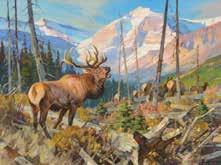
208.772.9009
HINES GOLDSMITHS
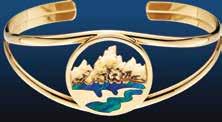
125 N Cache St 307.733.4028 CrazyHorseJewelry.com
cdaartauction.com

80 West Broadway 307.203.2322 gallerywild.com
Celebrating 50 Years Hines Goldsmiths is Jackson’s Fine Jewelry, hand etched Crystal and Glass Gallery. Our famous Teton Collection is available in Karat Golds or Sterling Silver in a range of sizes and prices with our Diamond pave and inlays of Opal or Turquoise highlighting our superb craftsmanship. In our Jackson studio we also create the Wyoming Bucking Bronco and custom Elk Ivory jewelry as well as Wyoming’s largest collection of unique gold and silver charms. Our dazzling collection of crystal and glass bar and giftware is hand etched with local wildlife. Custom pieces can also be created for weddings, anniversaries or business promotions.
80 Center Street (307) 733-5599 hines-gold.com

Native has been serving clients in Jackson Hole since 1983. We feature contemporary, museumquality fine art work and artisan, precious and semiprecious jewelry. Our fine art collection includes local landscapes, wildlife and one-of-a-kind Native American art. Whether you are searching for a handcrafted gold ring of the Tetons highlighted with a diamond or fine art painting featuring the beauty of the area, our curated selection and decades of experience will to connect you to Jackson Hole’s rich living history.
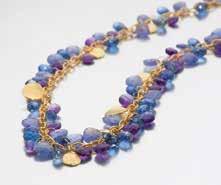
10 West Broadway 1.800.726.1803 NativeJH.com
Hand. Made. Things. Workshop is a boutique specializing in contemporary crafts by local and national artists and home to Susan Fleming’s jewelry studio. We offer a unique mix of locally handcrafted ceramics and jewelry, home goods, children’s gifts and apparel. We are located one block off the town square in the quaint grey house.
The National Museum of Wildlife Art is consistently recognized as a top attraction in Jackson Hole. The stunning building overlooks the National Elk Refuge and features 14 Masterwork Galleries, Museum Shop, Palate Restaurant, Children’s Discovery Gallery, Library, and outdoor Sculpture Trail. World-class exhibitions change regularly so there is always something new to see. Featuring work by prominent artists such as Georgia O’Keeffe, Andy Warhol, and Carl Rungius, the Museum’s unsurpassed permanent collection inspires humanity’s relationship with nature. The National Museum of Wildlife Art is a private 501(c)3 non-profit organization.
2820 Rungius Rd. 307.733.5771 www.WildlifeArt.org
Add a little sparkle to your life by stopping by A Touch of Class. Showcasing spectacular jewelry and sparkling keepsakes, A Touch of Class has been serving Jackson Hole since 1983. Our familyowned boutique features premium selections and exclusive charms from internationally renowned brands such as Swarovski® and Pandora, plus locally made charms and jewelry to serve as a thoughtful memento of your time in Jackson Hole.
“Bold, contemporary and original.” - Oona Doherty, Jackson Hole Center for the Arts.
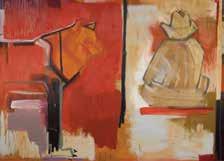
New West Fine Art features the work of Jackson native, Connor Liljestrom. Liljestrom’s running solo exhibition, The Last of the Old West, explores themes inspired by the artist’s life in the Tetons, mythologies, Hollywood and pop culture, natural history, colonialism, and the canon of Westerncentric art history. Open every day 10am - 6pm.
98 Center St, Unit C 307.730.9262
SUSAN FLEMING JEWELRY | WORKSHOP A TOUCH OF CLASS WEST LIVES ON

NewWestFineArt.com
The West Lives On Gallery features fine art reflecting the rich heritage of the American West. Featuring Western, wildlife and landscape art in our traditional and contemporary galleries. The West Lives On Gallery has been representing over 100 national and regional artists since 1998.
